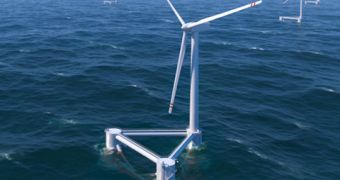The Sandia National Laboratories were recently commissioned by the US Department of Energy to look into the possibility of improving the overall efficiency of offshore wind technology.
Thus, the latter agreed to invest $4,1 million (about €3,32 million / ₤2,6 million) in a five-year project aimed at designing and manufacturing wind turbines which can successfully cut down on the present-day costs of harvesting off-shore wind power.
Josh Paquette, one of the specialists involved in this research, explains how, “Ultimately it’s all about the cost of energy. All these decisions need to lead to a design that’s efficient and economically viable.”
Apparently, the main drive behind this project is represented by the American government's decision to green-up the country and switch to more environmentally-friendly energy sources.
As explained on the official website for Sandia National Laboratories, scientists employed by this organization believe that, in order to harvest off-shore wind power more efficiently than in the past, it is crucial that vertical axis wind turbines (VAWTs) undergo a series of transformations.
Apparently, a lower center of gravity for the turbine, reduced complexity and having the drivetrain (i.e. the powertrain) installed at or very close to the surface would all translate into reduced maintenance costs and improved electricity generation capacity.
Josh Paquette makes a case of how, “VAWTs are elegant in terms of their mechanical simplicity. They have fewer parts because they don't need a control system to point hem toward the blowing wind to generate power.”
According to the same source, Sandia National Laboratories is presently testing various prototypes for such new and improved wind-turbines, but it is expected that the Darrieus design will be the winner in the end.
Last but not least, due consideration is given to the VAWTs' foundation, meaning that researchers are trying to find out whether these constructions would be much better supported by barges, tension-leg platforms or spar buoys.
Given the fact that harvesting off-shore wind energy is very much different than making the most out of on-shore wind power, it seems to us that efforts to improve on this particular branch of renewable energy sources are nothing if not a welcomed endeavor.

 14 DAY TRIAL //
14 DAY TRIAL //